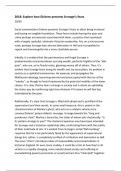2018: Explore how Dickens presents Scrooge’s fears.
29/30
Social commentator Dickens presents Scrooge’s fears as often being irrational
and having no tangible foundation. These fears include fearing the poor and
crime perhaps erroneously associated with them, a practise that resonated
with a largely capitalist, obstinate Victorian readership. Yet, on a microcosmic
scale, perhaps Scrooge fears eternal damnation in Hell and is propelled to
repent and transmogrify into a more charitable person.
Initially, it is evident that the parsimonious and frugal Scrooge is
predominantly concerned about accruing wealth, perfectly frightful of the “idle
poor”, who are, as he firmly insists, gleaning money off of others. Thus, it’s
evident that Scrooge fears losing his wealth and, by association, his position in
society as a capitalist businessman. He espouses and propagates the
Malthusian ideology, becoming worried and preoccupied with the rise of the
“surplus”, as though he feels threatened by the potential mobility of the lower
classes. It is clear that he fears a change in society and is intent on upholding
the status quo by reinforcing rigid class divisions if it means he will feel less
intimidated by the poor.
Additionally, it’s clear that Scrooge is filled with dread and is petrified of the
supernatural and their words. In some small measure, this is patent in the
characterisation of Marley’s ghost, who acts as a catalytic vehicle as he
conveys Dickens’ potent didactic message. Scrooge bewails the “long and
ponderous chain” Marley is bound by, the latter of whom asks rhetorically: “is
its pattern strange to you?” The rhetorical question may have been intended
for Scrooge and a Victorian readership alike, confronting them with the reality
of their multitude of sins. It’s evident from Scrooge’s initial “Bah humbug”
response that he’s not particularly fazed by the appearance of supernatural
beings but, rather, is completely terrified of retribution and damnation in Hell.
The noun “chain” introduces ideas of responsibility and connectedness in
Victorian England. Or even more crudely, it could be a hint at how they’re all
victims in a rapidly changing, more industrialised society and suffering in
overwhelming poverty (economic or social) and are thus “chain[ed]” together.
, Either way, the implication is clear: Scrooge’s fears of the lower classes are
unfounded and unjustified since all members of society are linked and
connected.
Furthermore, it can be argued that an innate fear of Scrooge’s is neglection
and isolation. Perhaps due to his fears of being neglected and isolated, Scrooge
has evolved to develop a calcified exterior around himself to shield and cocoon
his younger self from feelings of despair. This is emphasised through the
contradictory nature of the Ghost of Christmas Past, who can be said to
represent and embody Scrooge’s myriad of suppressed emotions. The Ghost is
described as being “like an old man” and “child” simultaneously suggesting
how perhaps the Ghost is a manifestation of Scrooge’s suppressed childhood
state as though, due to his abject neglection, he has grown up deprived of
maternal love and general care that is, in many ways, reminiscent of childhood
despite him being older now. This is further reinforced by the tentative tone he
adopts when he says, in Stave 5, “will you let me in?” to Fred. The question
almost oozes apprehension, as though Scrooge is positively terrified of Fred’s
response and fears his rejection. Thus, it’s clear how Scrooge has an
unshakeable fear of being neglected, rejected and uncared for: he retains this
throughout adulthood, a reminder to Victorians how inimical and injurious it is
to condemn children to certain things whilst they’re developing such as the
common practise of sending off boys to boarding school.
Moreover, in the extract, Dickens cleverly uses prolepsis to offer a glimpse of
Scrooge’s solitary death. The Phantom appears to be a representation of death
and the Grim Reaper, embellishing the concept of memento mori. The triplet
“slowly, gravely, silently approached” sums up how slow and agonising
Scrooge’s life and death may be, torturously playing on Scrooge’s fear of death
itself. The sinister sibilant sounds conveyed here echo how quiet it has
become- the entire purpose of the Phantom can be to remind Scrooge of his
inevitable death and to vividly emblazon into his mind how lonely and
neglected he will remain if he fails to change. Yet, the fact that Scrooge can
“grasp” the spectral hand (metaphorically of time perhaps) suggests how he
can very clearly change the future if he is genuinely remorseful. In contrast,
Scrooge could not hide the light of the Ghost of Christmas Past, implying how




